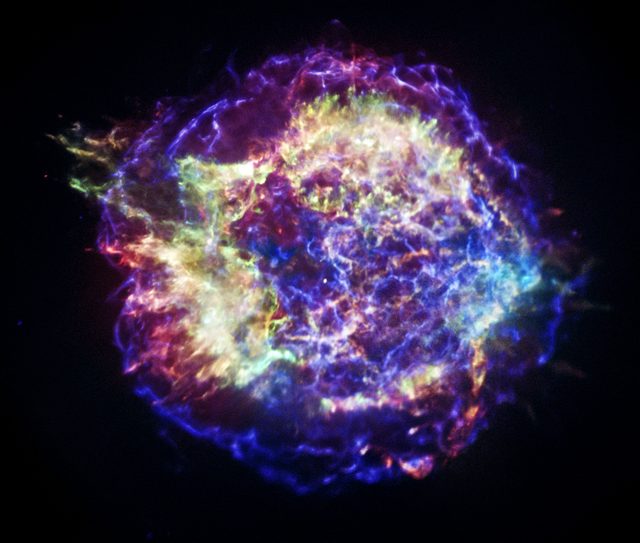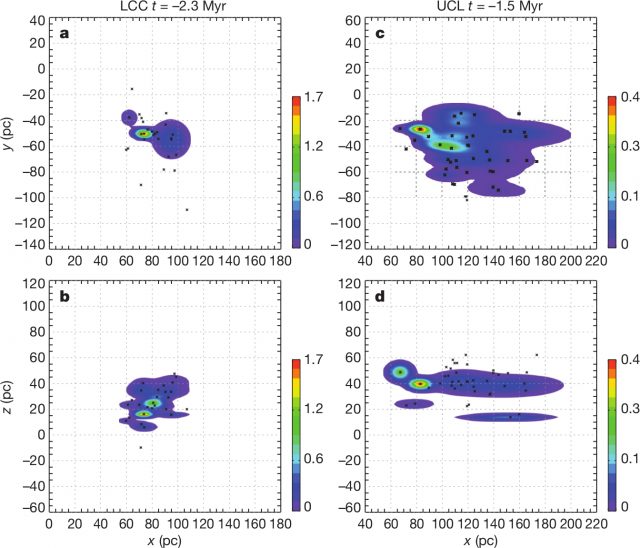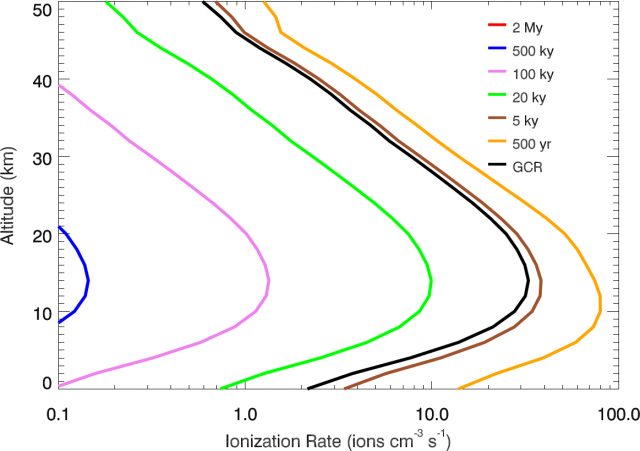Cloudy, with a chance of supernova

We live in a violent universe. The energy scales involved in many astrophysical processes are enough to stamp out our planet, not to talk about life as we know it. But, somehow, we have been living so far in a delicate equilibrium. Such equilibrium has been punctuated by relatively modest catastrophes that have possibly shaped our evolution; the Damocles’ sword is hanging over our heads and there is no much we can do about it, except keep an eye on the sky.
One of the most common hazards is the supernova explosion. This is the end of life for many stars more massive than our Sun, a behemoth explosion that liberates in a single event the same amount of energy our star will produce during its whole lifetime. A good fraction of this energy is released in the form of high energy photons (from ultraviolet to gamma-rays), producing not exactly the suntan you would like to get. Many studies have dealt with the problem of how close to such explosions we could survive. The “kill zone” seems to be determined by a substantial depletion of our ozone layer, which protects us from hard UV rays and enables life on Earth’s surface. Gehrels and collaborators fixed the limit at 8 pc (1 parsec is equal to 3.26 light-years) 1. Even though we think there are about two supernova explosions per century in our galaxy, events within the kill zone are obviously scarcer and might occur just once every 1,500 million years. Therefore, not a likely cause for massive extinctions, at least from a Hollywoodesque point of view.
However, supernovae are not just destruction. Nucleosynthesis at star cores stops at iron and nickel, elements that are no longer able to produce energy through nuclear fusion and condemn the star to death. Elements heavier than iron are produced in the shock waves that follow, spreading metals (anything heavier than Helium in astronomical jargon) throughout the surrounding interstellar medium (ISM). One of the most interesting isotopes is radioactive iron-60 (60Fe), whose half-life of 2.6 million years is an optimal clock for the investigation of the Universe around us. In fact, we live in a bubble of low density filled with hot coronal gas, the Local Bubble. This anomaly of the ISM was most likely caused by a number of supernova explosions in the last few million years but when and where they happened was mostly a mystery until this year.
Previous efforts had analyzed a sphere around us looking for the lower mass companions of the massive stars that had already exploded. It is common that O- and B- type stars (the hottest and most massive ones) are born together and live in what we call OB associations. This does not last long, though, since O blue giant stars cannot live more than a few million years and finally explode. Find the B stars and you might find clues for the lost O stars. This idea was for example followed by Maíz-Apellániz 2 when he found that Scorpius-Centaurus OB association was located near the Sun some 5 million years ago and a sub-group of such association could be responsible of the Local Bubble.

This year, some works have followed just the opposite effort, tracing the back the deposit of 60Fe in (or close to) our planet. Breitschwerdt and collaborators 3 computed the most probable trajectories of supernova progenitors in order to find the time and location of the explosions. Most of the Local Bubble was formed by two events some 2 million years ago at approximately 100 pc from the Earth. The rest of supernovae happened farther away in space and time, so they contributed less to the current bubble and hence to the iron-60 deposits on our planet. Even though this work may be affected by the models of iron transport throughout the ISM, it provides an unprecedented precision for the origin of 60Fe deposits in the ocean crusts.
This work has been accompanied by three other studies that substantially increment our understanding of the iron-60 deposits. Wallner et al. 4 have studied the deposition of 60Fe in all major oceans of our planet. Their results essentially agree with the results by Breitschwerdt et al. (2016) and show the influx of iron in the last 10 million years. On the other hand, Fimiani and collaborators 5 also reported the detection of the same isotope in the lunar samples from the Apollo missions. Lunar samples are expected to have iron-60 due to spallation produced by solar and galactic cosmic rays but, the companion isotope 53Mn confirms the supernova origin. To perfect this picture, the detection of just fifteen 60Fe nuclei in the cosmic rays 6 passing through our vicinity during the last 70 years fits nicely into the model of a few (2) close (100 pc) supernovae in relatively recent times (2 million years).
At this point, the last question is whether or not those explosions had any effect in the atmosphere of the Earth and in the organisms living on its surface or in the upper part of the oceans. Thomas et al. have studied a number of possible past supernovae and study the effects in a very recent paper. In agreement with the work by Gehrels, no substantial ozone depletion is expected. However, they show a tropospheric ionization by cosmic rays down to the surface that could have last for thousands of years. Radiation load on organisms could have been tripled during that period and the increase of cosmic rays may reached levels that have not been simulated in climate models yet. This might leave a detectable footprint in the fossil record and deserves further research in particular regarding the minor mass extinction that happened at the Pliocene-Pleistocene boundary.

References
- N. Gehrels et al. (2003). Ozone depletion from nearby supernovae. The Astrophysical Journal 585, 1169 – 1176. doi: 10.1086/346127 ↩
- J.M. Apellániz (2001). The origin of the Local Bubble. The Astrophysical Journal 560, L83 – L86. doi: 10.1086/324016 ↩
- D. Breitschwerdt et al. (2016). The locations of recent supernovae near the Sun from modelling 60Fe transport. Nature 532, 73 – 76. doi: 10.1038/nature17424 ↩
- A. Wallner et al. (2016). Recent near-Earth supernovae probed by global deposition of interstellar radiactive 60Fe. Nature 532, 69 – 72. doi: 10.1038/nature17196 ↩
- L. Fimiani et al. (2016). Interstellar 60Fe on the surface of the Moon. Physical Review Letters 116, 151104. doi: 10.1103/PhysRevLett.116.151104 ↩
- B.C. Thomas et al. (2016). Terrestrial effects of nearby supernovae in the early Pleistocene. The Astrophysical Journal Letters 826, L3. doi: 10.3847/2041-8205/826/1/L3 ↩